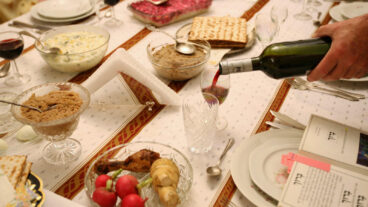A wooden falafel and pita holder designed by students from Rishon Lezion’s Eshkelot Hapayis program.Over a thousand Israeli junior high school students have spent countless hours over the last seven months meeting and learning about people with special needs. The teens have been participating in an innovative national program called ‘I Can Do It’, in which they invented devices, gadgets, games and product designed to make lives a little easier for those with disabilities.
The program was created to open up two new worlds to the young people who participate – the world of science and technology and the world of the disabled.
More than 90 ‘I Can Do It’ projects were recently on exhibit at the Eshkol Hapayis youth center in Yavne, a center built and funded by Israel’s national lottery – Mifal Hapayis – one of 76 such facilities in the country which host the program.
‘I Can Do It’ is the brainchild of Dr. Ronit Ashkenasy, who heads the Science and Technology Department of Eshkolot Hapayis. Ashkenasy completed her PhD. in biotechnology at Israel’s prestigious Technion in Haifa. “After I finished, I realized that I wanted to work with people, so I decided to work in education,” she told ISRAEL21c.
The idea for the project began to hatch soon after Ashkenasy began her job at the Eshkolot department nine years ago. “Talking to different educators, I realized that young people were living in a virtual world. Children knew how to use a joystick, but they did not know how to use their hands to make anything. They did not know how to create a device – make a design, make a drawing into a plan, use actual materials to build a product, and to check to see if it was useful,” she said.
A major benefit of the program is that the teenagers also learn to appreciate and respect the challenges that simple everyday tasks can pose for disabled individuals – such as taking off a shirt, turning the pages of a book, or picking something up from the floor.
Under the program’s framework, the students meet with a person with special needs, identify a specific challenge, check to see if other devices have been designed to meet this need, develop a prototype and then improve it through product testing with the disabled person. Students develop their products during their regular science and technology lessons or during special after-school clubs.
At the end of the program, prizes are awarded on two levels: to the design teams of the best devices, and to the Eshkolot Hapayis staffs who have developed the best educational support programs for the student design teams.
The closing awards ceremony attended both by the students and people with special needs was emotional and stirring.
“Everyone has a dream, some dream of becoming a lawyer, some dream of flying abroad,” said wheelchair-bound Zadok Omazi, speaking during the ceremony. “My dream was to eat a falafel and pita without help. Today, I can do what for me was once impossible.”
Amazi’s dream came true thanks to a wooden falafel and pita holder designed just for him by students in Rishon Lezion’s Eshkelot Hapayis program.
The inventions that made it to the finals were honored with certificates included a wheelchair swivel on a ball-bearing base, a decorated garbage pail with a remote control to bring it closer, an easy-to-use computer menu, a thick red plastic belt with curved ends for hands-free carrying, a one-unit knife and fork, a wooden contraption to make the job of putting on and taking off shoes easier, a toothpaste presser, a walking stick with a 1.5 meter distance detector that buzzes before an obstacle, a diaper with a disposable sensor that plays a musical melody when it is wet.
Nine teams of students received top prizes at the award-winning ceremony, and three of the 35 participating centers were recognized.
One clear winner was the “hot” phone designed by 7th grade students from Kiryat Yam.
“We met with Doron, a blind young man, and talked to him about his fears,” said team leader, Hagit Mizrachi. “He was afraid to go for walks because besides being blind, he had episodes of epilepsy. He worried about falling and not being able to call for help.”
Doron feared that his young seeing-eye dog would not be able to rescue him either.
“We thought about different solutions. Our idea was to add a special button on his mobile phone which the dog could be trained to press, and also to incorporate a GPS system to direct rescuers to Doron,” said Mizrachi.
The enterprising youngsters wrote a letter to the head of the mobile phone company, Pelephone, and asked for technical assistance. The company helped to design a phone with a large button that the dog could press, which would also activate the GPS.
Beauty and grooming are also needs that were addressed. A team from the Petah Tikva Eshkolot designed an apparatus called “Lak Kal,” (Easy Nail Polish) to make it easier for people with shaking hands to put on nail polish.
One of the most colorful displays was Cipi, an animated clown face that doubled as an exercise facilitator for children with cystic fibrosis.
“The children said it was boring, boring, boring to do the physiotherapy exercises needed to get phlegm out of their lungs,” said Tammi Ben Shahat, the group’s counselor.
Yavne teenagers came up with the idea of a clown. When the children blow in and out, the clown’s eyes light up, little styrofoam balls somersault through a curved pipette, and the clown smiles.
Creating action and other outdoor equipment for a park suited to the special needs population, was the grand plan of ninth graders in Emek Hefer. An outdoor Sudoku game was a winner in the category of Creativity and Quality of Design.
“It can be played by blind people and people with limited sight,” said 15 ½ year old Daria Akerman, originator of the concept for Sudo-Kef (Kef means fun in Hebrew).
The game’s colorful, glittery numbers are raised slightly; but to be sure a blind person can play the game, each cube also has raised Braille dots to correspond to the number.
Several of the participants said they were motivated by the needs of the elderly, sometimes their own grandparents.
“My grandfather had trouble picking things up from the floor,” said Noa Eden. She and her teammates Sapir Maimon, Steve Erez, and Keren Meir also won the prize (in the category ‘creativity and quality of the product’) for a stick with different attachments at the end for picking up objects.
Ram Oren from Ra’anana said that his grandmother had trouble opening and closing a window in her apartment. Oren decided to attach an automatic device, so that the task would not require physical dexterity. The automatic moving window was a winner in the category of practical applications.
Youngsters from the town of Binyamina visited a nearby old age home and met a man told them that he wanted to read, but that he could not turn the pages of a book. He was grateful when the young people came up with the idea of a glove with sticky material so that he could turn the page.
As part of the program, the participants learn how to identify a need, assess its requirements, brainstorm, check existing solutions, consider modifications, and target an audience.
“Each prototype product is judged according to specific criteria,” says Dr. Sherman Rosenfeld, a Weizmann Institute science educator who served as one of the six judges.
The criteria are the following: 1) Does it fill a real and specific need? 2) Creativity and originality; 3) Explanation of the relevant science and technology concepts; 4) Usefulness; 5) Product Quality; 6) Presentation.
“It was very difficult to pick winners,” says judge Shosh Goldberg-Mayer, one of the founders of Milbat, the non-profit center for services for the disabled in Israel, established in 1981. Goldberg-Mayer recalls that she was very excited when Ashkenasi called to tell her the idea for the ‘I Can Do It’ program.
Goldberg-Mayer, a polio victim from childhood, says that one of the purposes of the program is to teach the teenagers how to relate to the disabled.
“Being disabled is not a stigma, it is not contagious. We teach the participants how to talk to people with special needs,” she told ISRAEL21c.
“I began to understand the life of the disabled, to empathize. We all have some handicaps; some are visible, and some are not,” said one participant.
“During the period of adolescence angst – the project helps the kids to look outside of themselves, see how other people suffer, and how an individual can help. They are inspired by the daily courage of the disabled. They learn from science and technology how to apply skills. The key thing we have learned is that people, disabled or not, have a human drive for autonomy. Teenagers identify with this need,” said Rosenfeld.
As Ofer Jan, in charge of Milbat’s central data base of equipment and accessories and himself wheelchair-bound, said at the award ceremony: “Each one of you has won a prize by participation in the competition. You understand that little things can improve the life of the disabled. Each device you have created helps us to live a more independent life.”












